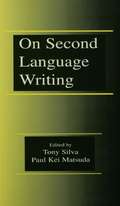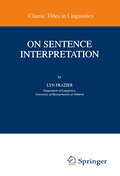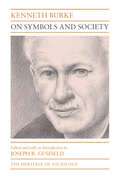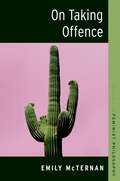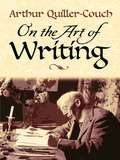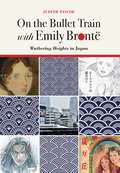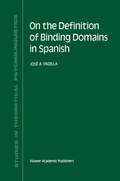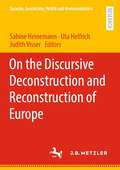- Table View
- List View
On Second Language Writing: Perspectives On The Process Of Knowledge Construction
by Tony Silva Paul Kei MatsudaOn Second Language Writing brings together internationally recognized scholars in a collection of original articles that, collectively, delineate and explore central issues with regard to theory, research, instruction, assessment, politics, articulation with other disciplines, and standards. In recent years, there has been a dramatic growth of interest in second-language writing and writing instruction in many parts of the world. Although an increasing number of researchers and teachers in both second-language studies and composition studies have come to identify themselves as specialists in second-language writing, research and teaching practices have been dispersed into several different disciplinary and institutional contexts because of the interdisciplinary nature of the field. This volume is the first to bring together prominent second-language writing specialists to systematically address basic issues in the field and to consider the state of the art at the end of the century (and the millennium).
On Second Language Writing
by Tony Silva Paul Kei MatsudaOn Second Language Writing brings together internationally recognized scholars in a collection of original articles that, collectively, delineate and explore central issues with regard to theory, research, instruction, assessment, politics, articulation with other disciplines, and standards. In recent years, there has been a dramatic growth of interest in second-language writing and writing instruction in many parts of the world. Although an increasing number of researchers and teachers in both second-language studies and composition studies have come to identify themselves as specialists in second-language writing, research and teaching practices have been dispersed into several different disciplinary and institutional contexts because of the interdisciplinary nature of the field. This volume is the first to bring together prominent second-language writing specialists to systematically address basic issues in the field and to consider the state of the art at the end of the century (and the millennium).
On Secrets (On Series)
by Annika SmethurstOn June 4, Federal Police raided the home of Walkley award-winning journalist Annika Smethurst, changing her life forever.Police claim they were investigating the publication of classified information, her employer called it a 'dangerous act of intimidation', Smethurst believes she was simply doing her job.Smethurst became the accidental poster woman for press freedom as politicians debated the merits of police searching through her underwear drawer. In On Secrets she will discuss the impact this invasion has had on her life, and examine the importance of press freedom.
On Sentence Interpretation (Studies in Theoretical Psycholinguistics #22)
by Lyn FrazierAt present there exists no empirically-motivated theory of how perceivers assign a grammatically-permissible interpretation to a sentence. Implicit in many investigations of language comprehension is the idea that each constituent of a sentence is interpreted by the perceiver at the earliest conceivable point, using all potentially relevant sources of information. A variety of counter examples are presented to argue against this implicit theory of sentence interpretation. It is argued that an explicit alternative theory is needed to specify which decisions are made at which points during interpretive processing and to spell out the principles governing the processor's preferred choice at points of ambiguity or uncertainty. Several specific issues are taken concerning how the processor assigns a focal structure to an input sentence, how it identifies the topic of the sentence, how implicit restrictors on the domain of quantification are interpreted and how the identification of the content of a restrictor may guide the processor's use of discourse information. Exploiting intuitions about preferred interpretations of ambiguous sentences as well as the results of both old and new experimental studies, a theory of the preferred interpretation of Determiner Phrases is presented. This work explores important, but overlooked questions in on-line sentence interpretation and attempts to erect some of the scaffolding for an eventual theory of sentence interpretation.
On Shell Structure (Routledge Leading Linguists)
by Richard K. LarsonThis volume collects together core papers by Richard K. Larson developing what has since come to be known as the "VP Shell" or "Split VP" analysis of sentential structure. The volume includes five previously published papers together with two major unpublished works from the same period: "Light Predicate Raising" (1989), which explores the interesting consequences of a leftward raising analysis of "NP Shift" phenomena, and "The Projection of DP (and DegP)" (1991), which extends the shell approach to the projection of nominal and adjectival structure, showing how projection can be handled in a uniform way. In addition to published, unpublished and limited distribution work, the volume includes extensive new introductory material. The general introduction traces the conceptual roots of VP Shells and its problems in the face of subsequent developments in theory, and offers an updated form compatible with modern Minimalist syntactic analysis. The section introductions to the material on datives, complex predicates and nominals show how the updated form of shell theory applies in the empirical domains where it was originally developed.
On Shell Structure (Routledge Leading Linguists)
by Richard K. LarsonThis volume collects together core papers by Richard K. Larson developing what has since come to be known as the "VP Shell" or "Split VP" analysis of sentential structure. The volume includes five previously published papers together with two major unpublished works from the same period: "Light Predicate Raising" (1989), which explores the interesting consequences of a leftward raising analysis of "NP Shift" phenomena, and "The Projection of DP (and DegP)" (1991), which extends the shell approach to the projection of nominal and adjectival structure, showing how projection can be handled in a uniform way. In addition to published, unpublished and limited distribution work, the volume includes extensive new introductory material. The general introduction traces the conceptual roots of VP Shells and its problems in the face of subsequent developments in theory, and offers an updated form compatible with modern Minimalist syntactic analysis. The section introductions to the material on datives, complex predicates and nominals show how the updated form of shell theory applies in the empirical domains where it was originally developed.
On Symbols and Society (Heritage of Sociology Series)
by Kenneth BurkeKenneth Burke's innovative use of dramatism and dialectical method have made him a powerful critical force in an extraordinary variety of disciplines—education, philosophy, history, psychology, religion, and others. While most widely acclaimed as a literary critic, Burke has elaborated a perspective toward the study of behavior and society that holds immense significance and rich insights for sociologists. This original anthology brings together for the first time Burke's key writings on symbols and social relations to offer social scientists access to Burke's thought. In his superb introductory essay, Joseph R. Gusfield traces the development of Burke's approach to human action and its relationship to other similar sources of theory and ideas in sociology; he discusses both Burke's influence on sociologists and the limits of his perspective. Burke regards literature as a form of human behavior—and human behavior as embedded in language. His lifework represents a profound attempt to understand the implications for human behavior based on the fact that humans are "symbol-using animals." As this volume demonstrates, the work that Burke produced from the 1930s through the 1960s stands as both precursor and contemporary key to recent intellectual movements such as structuralism, symbolic anthropology, phenomenological and interpretive sociology, critical theory, and the renaissance of symbolic interaction.
On Sympathetic Grounds: Race, Gender, and Affective Geographies in Nineteenth-Century North America
by Naomi GreyserWith its filigreed, formidable representations of tears and suffering, sentimentalism has remained a divisive genre and category of analysis. On Sympathetic Grounds offers a new interpretation of the sentimental by mapping its grounds in North America. During sweeping transformations of territory, land stewardship, personhood, and citizenship in the nineteenth century, sentimentalists evoked sympathy to express a desire for a place that was both territorial and emotional--what Naomi Greyser calls an "affective geography." Greyser traces the intricacies attending Americans' sentimental sense that bodies could merge and mutually occupy the same space at the same time. Affective geographies complicate normative, linear assumptions about intimacy and distance, and consequently compel a reconsideration of geopolitics, geophysics and the distribution of resources and care. Mapping feelings in and also about space, On Sympathetic Grounds focuses on the experiences and perspectives of those whose bodies, labor and sovereignty have been occupied to ground others' lives and world-making projects. Bringing literary and rhetorical studies together with critical race and gender theory, cultural geography, American studies, affect studies and the new materialism, this book lays out sentimentalism's usefulness to settler colonialism and the maintenance of racialized labor. The book also carefully charts sentimentalism's value as a means of resisting geographic displacement and both physical and metaphysical dispossession. Philosophers and rhetoricians regard grounds as necessary conditions for argumentation; Greyser treats grounds as also geopolitical, geoaffective, and geophysical. Sympathy has enriched conditions for living at the same time that it has mercilessly enlisted some bodies and lives as the grounds for others' wellbeing. Ultimately, On Sympathetic Grounds uncovers a moving, non-linear cartography of sympathy's vital place in shaping North America.
On Sympathetic Grounds: Race, Gender, and Affective Geographies in Nineteenth-Century North America
by Naomi GreyserWith its filigreed, formidable representations of tears and suffering, sentimentalism has remained a divisive genre and category of analysis. On Sympathetic Grounds offers a new interpretation of the sentimental by mapping its grounds in North America. During sweeping transformations of territory, land stewardship, personhood, and citizenship in the nineteenth century, sentimentalists evoked sympathy to express a desire for a place that was both territorial and emotional--what Naomi Greyser calls an "affective geography." Greyser traces the intricacies attending Americans' sentimental sense that bodies could merge and mutually occupy the same space at the same time. Affective geographies complicate normative, linear assumptions about intimacy and distance, and consequently compel a reconsideration of geopolitics, geophysics and the distribution of resources and care. Mapping feelings in and also about space, On Sympathetic Grounds focuses on the experiences and perspectives of those whose bodies, labor and sovereignty have been occupied to ground others' lives and world-making projects. Bringing literary and rhetorical studies together with critical race and gender theory, cultural geography, American studies, affect studies and the new materialism, this book lays out sentimentalism's usefulness to settler colonialism and the maintenance of racialized labor. The book also carefully charts sentimentalism's value as a means of resisting geographic displacement and both physical and metaphysical dispossession. Philosophers and rhetoricians regard grounds as necessary conditions for argumentation; Greyser treats grounds as also geopolitical, geoaffective, and geophysical. Sympathy has enriched conditions for living at the same time that it has mercilessly enlisted some bodies and lives as the grounds for others' wellbeing. Ultimately, On Sympathetic Grounds uncovers a moving, non-linear cartography of sympathy's vital place in shaping North America.
On Syntax of Negation (Routledge Library Editions: Syntax #14)
by Itziar LakaThe central concern of this title, first published in 1994, is the syntactic nature of negation in Universal Grammar, and its relation to other functional elements in the Syntax. The study argues that negation is not a syntactic category on its own; rather, it is one of the values of a more abstract syntactic category, named Σ, which includes other sentence operators, such as affirmation and emphasis. This title will be of interest to students of language and linguistics.
On Syntax of Negation (Routledge Library Editions: Syntax)
by Itziar LakaThe central concern of this title, first published in 1994, is the syntactic nature of negation in Universal Grammar, and its relation to other functional elements in the Syntax. The study argues that negation is not a syntactic category on its own; rather, it is one of the values of a more abstract syntactic category, named Σ, which includes other sentence operators, such as affirmation and emphasis. This title will be of interest to students of language and linguistics.
On Taking Offence (STUDIES IN FEMINIST PHILOSOPHY SERIES)
by Emily McTernanSomeone fails to shake your outstretched hand, puts you down in front of others, or makes a joke in poor taste. Should we take offence? Wouldn't it be better if we didn't? In the face of popular criticism of people taking offence too easily, and the social problems that creates, Emily McTernan defends taking offence as often morally appropriate and socially valuable. Within societies marred by inequality, taking offence can resist the day-to-day patterning of social hierarchies. This book defends the significance of details of our social interactions. Cumulatively, small acts, and the social norms underlying these, can express and reinforce social hierarchies. But by taking offence, we mark an act as an affront to our social standing. We also often communicate our rejection of that affront to others. At times, taking offence can be a way to renegotiate the shared social norms around what counts as respectful treatment. Rather than a mere expression of hurt feelings then, to take offence can be to stand up for one's standing. When taken by those deemed to have less social standing, to take offence can be a direct act of insubordination against a social hierarchy. Taking offence can resist everyday inequalities. In unequal societies, the inclination to take offence at the right things, and to the right degree, may even be a civic virtue. These right things at which to take offence include many of the very instances that the opponents of a culture of taking offence find most objectionable: apparently trivial and small-scale details of our social interactions.
On Taking Offence (STUDIES IN FEMINIST PHILOSOPHY SERIES)
by Emily McTernanSomeone fails to shake your outstretched hand, puts you down in front of others, or makes a joke in poor taste. Should we take offence? Wouldn't it be better if we didn't? In the face of popular criticism of people taking offence too easily, and the social problems that creates, Emily McTernan defends taking offence as often morally appropriate and socially valuable. Within societies marred by inequality, taking offence can resist the day-to-day patterning of social hierarchies. This book defends the significance of details of our social interactions. Cumulatively, small acts, and the social norms underlying these, can express and reinforce social hierarchies. But by taking offence, we mark an act as an affront to our social standing. We also often communicate our rejection of that affront to others. At times, taking offence can be a way to renegotiate the shared social norms around what counts as respectful treatment. Rather than a mere expression of hurt feelings then, to take offence can be to stand up for one's standing. When taken by those deemed to have less social standing, to take offence can be a direct act of insubordination against a social hierarchy. Taking offence can resist everyday inequalities. In unequal societies, the inclination to take offence at the right things, and to the right degree, may even be a civic virtue. These right things at which to take offence include many of the very instances that the opponents of a culture of taking offence find most objectionable: apparently trivial and small-scale details of our social interactions.
On Teacher Neutrality: Politics, Praxis, and Performativity
by Daniel P. RichardsOn Teacher Neutrality explores the consequences of ideological arguments about teacher neutrality in the context of higher education. It is the first edited collection to focus exclusively on this contentious concept, emphasizing the practical possibilities and impossibilities of neutrality in the teaching of writing, the deployment of neutrality as a political motif in the public discourse shaping policy in higher education, and the performativity of individual instructors in a variety of institutional contexts. The collection provides clarity on the contours around defining “neutrality,” depth in understanding how neutrality operates differently in various institutional settings, and nuance in the levels and degrees of neutrality—or what is meant by it—in the teaching of writing. Higher education itself and its stakeholders are continually exploring the role of teachers in the classroom and the extent to which it is possible or ethical to engage in neutrality. Amplifying voices from teachers in underrepresented positions and institutions in discussions of teacher ideology, On Teacher Neutrality shapes the discourse around these topics both within the writing classroom and throughout higher education. The book offers a rich array of practices, pedagogies, and theories that will help ground instructors and posits a way forward toward better dialogue and connections with the various stakeholders of higher education in the United States. Contributors: Tristan Abbott, Kelly Blewett, Meaghan Brewer, Christopher Michael Brown, Chad Chisholm, Jessica Clements, Jason C. Evans, Heather Fester, Romeo García, Yndalecio Isaac Hinojosa, Mara Holt, Erika Johnson, Tawny LeBouef Tullia, Lauren F. Lichty, Adam Pacton, Daniel P. Richards, Patricia Roberts-Miller, Karen Rosenberg, Allison L. Rowland, Robert Samuels, David P. Stubblefield, Jennifer Thomas, John Trimbur
On the Art of Medieval Arabic Literature
by Andras HamoriIn applying the standards of modern literary criticism to medieval Arabic literature, Andras Hamori concentrates on those aspects of the literature that appear most alien to modern Western taste: the limitation of themes, the sedimentation with conventions, and the use of elusive patterns of composition.The first part of the book approaches Arabic literature from the historical point of view, concentrating on the transformations in poetic genres and poetic attitudes towards time and society in the literature between the sixth and the tenth centuries. The problems of poetic technique are then discussed, with special emphasis on poetic unity and the use of conventions. The third part of the book deals with methods of composition in prose through an examination of the orders and disorders in two tales from the Arabian Nights.Originally published in 1974.The Princeton Legacy Library uses the latest print-on-demand technology to again make available previously out-of-print books from the distinguished backlist of Princeton University Press. These editions preserve the original texts of these important books while presenting them in durable paperback and hardcover editions. The goal of the Princeton Legacy Library is to vastly increase access to the rich scholarly heritage found in the thousands of books published by Princeton University Press since its founding in 1905.
On the Art of Writing
by Arthur Quiller-Couch"The art of writing is a living business," declares Sir Arthur Quiller-Couch in the Preface to this classic. "Literature is not a mere science, to be studied; but an art, to be practiced. Great as is our own literature, we must consider it as a legacy to be improved . . . if we persist in striving to write well, we can easily resign to other nations all the secondary fame."Renowned as a critic, teacher, and educational reformer, Quiller-Couch delivered a series of lectures at the University of Cambridge in 1913-14. His subjects--the artistic and vital nature of language as well as the skills needed to convey and receive the written word--remain as timeless as his advice. This book contains the eminent scholar's remarks from those lectures on the practice of writing, the difference between verse and prose, the use of jargon, the history of English literature, the ways in which English literature is taught at the university, and the importance of style. The principles and practical guidelines he sets forth in this volume offer aspiring writers an enduring source of guidance.
On the Artistic Representation of Industrial Disputes in the Shadow of Repression in European Art: From 1870 to 1914 and Beyond (Law and Visual Jurisprudence #15)
by Filip DorssemontThis book is the first volume on the artistic representation of industrial disputes in European art (from 1870 to 1914) since the catalogue of the landmark exhibition Streik, Realität und Mythos, organized by the Deutsches Historisches Museum (1992). It has been written by a group of scholars who share a keen interest in social history and the history of art, as well as in-depth knowledge of industrial relations and collective labour law. Seeking to transcend a purely western European perspective, the book offers unprecedented insights into artistic production in Poland and Hungary from the 19th century to the communist era. It even goes beyond the European continent, examining the United States and Mexico. The media explored include painting, sculpture, the graphic arts and photography. Further, the book deals with artists great (Carlo Carrà, Walter Crane, James Ensor, Juan Gris, Käthe Kollwitz, Constantin Meunier,Mihály Munkácsy, Théophile-Alexandre Steinlen and Jan Toorop) and small, sometimes even anonymous. The artistic styles range from (social) realism, naturalism and neo-impressionism to futurism and socialist realism. All stages of industrial disputes (from the causes of strikes to their violent suppression) are subjected to iconographical and iconological analysis, combined with perspectives from visual studies, critical art and gender studies. Agricultural workers, miners, construction workers and textile workers fill the scenes. Most of them are subordinate workers; others are (bogus) independent workers and migrant workers. Given its scope, the book will be of interest to (art) historians, labour law scholars, and specialists in industrial relations.
On the Avenue of the Mystery: The Postwar Counterculture in Novels and Film (Routledge Studies in Twentieth-Century Literature)
by Gary HentziThis volume is a study of eight major novels from the postwar period (1945-65) in conjunction with the films made from them during a later period of a little less than three decades straddling the millennium (1985-2012). The comparison of these novels (by Ken Kesey, Paul Bowles, Carson McCullers, Jack Kerouac, James Baldwin, Alexander Trocchi, William Burroughs, and Peter Matthiessen) with their film adaptations offers the opportunity for a historical reassessment not only of the novels themselves but also of the global counterculture of the years 1965-75, which they prefigure in a variety of ways. Appearing more than a decade after the waning of the counterculture and in some cases as much as fifty years after the novels on which they are based, the films display significant revisions and omissions prompted by the historical and cultural changes of the intervening years. Whereas these changes are nowadays often interpreted in purely political terms, this book argues that the religious theme of mystery and its decline is central to the novels and films and is a key feature of the period of cultural transformation that they bookend. At once a work of literary criticism, film studies, and cultural history, this text has the potential to reach both an academic audience and the broader readership that has long existed for these novels as well as the even broader one interested in reappraising the period of the global counterculture—among the most important of the influences that have shaped the contemporary world.
On the Avenue of the Mystery: The Postwar Counterculture in Novels and Film (Routledge Studies in Twentieth-Century Literature)
by Gary HentziThis volume is a study of eight major novels from the postwar period (1945-65) in conjunction with the films made from them during a later period of a little less than three decades straddling the millennium (1985-2012). The comparison of these novels (by Ken Kesey, Paul Bowles, Carson McCullers, Jack Kerouac, James Baldwin, Alexander Trocchi, William Burroughs, and Peter Matthiessen) with their film adaptations offers the opportunity for a historical reassessment not only of the novels themselves but also of the global counterculture of the years 1965-75, which they prefigure in a variety of ways. Appearing more than a decade after the waning of the counterculture and in some cases as much as fifty years after the novels on which they are based, the films display significant revisions and omissions prompted by the historical and cultural changes of the intervening years. Whereas these changes are nowadays often interpreted in purely political terms, this book argues that the religious theme of mystery and its decline is central to the novels and films and is a key feature of the period of cultural transformation that they bookend. At once a work of literary criticism, film studies, and cultural history, this text has the potential to reach both an academic audience and the broader readership that has long existed for these novels as well as the even broader one interested in reappraising the period of the global counterculture—among the most important of the influences that have shaped the contemporary world.
On the Bullet Train with Emily Brontë: Wuthering Heights in Japan
by Judith PascoeWhile teaching in Japan, Judith Pascoe was fascinated to discover the popularity that Emily Brontë’s novel Wuthering Heights has enjoyed there. Nearly one hundred years after its first formal introduction to the country, the novel continues to engage the imaginations of Japanese novelists, filmmakers, manga artists, and others, resulting in numerous translations, adaptations, and dramatizations. On the Bullet Train with Emily Brontë is Pascoe’s lively account of her quest to discover the reasons for the continuous Japanese embrace of Wuthering Heights. At the same time, the book chronicles Pascoe’s experience as an adult student of Japanese. She contemplates the multiple Japanese translations of Brontë, as contrasted to the single (or nonexistent) English translations of major Japanese writers. Carrying out a close reading of a distant country’s Wuthering Heights, Pascoe begins to see American literary culture as a small island on which readers are isolated from foreign literature.
On the Compositional Nature of the Aspects (Foundations of Language Supplementary Series #15)
by H.J. VerkuylThis book is a thesis submitted to the Faculty of Arts of the University of Utrecht. It was prepared under the supervision of Prof. Dr. H. Schultink. I would like to express my gratitude to him for his criticisms of earlier versions which led to many improvements, in particular with respect to the exposition of the argument. To my co-referent Dirk van Dalen, reader in the Department of Philo sophy (,Centrale Interfaculteit') of the University of Utrecht, I am greatly indebted for his valuable and fruitful suggestions about problems relevant to both linguistics and logic. Several ideas developed in this study owe their present concrete form to our many discussions. This thesis originates in syntactic research into the Aspects carried out in 1967 under the supervision of Albert Kraak, professor at the University of Nijmegen, who ever since gave much attention to my work in progress. I am very grateful to him for his careful and stimulating criticism as well as for the continuous support he gave me during these years. The present study closely relates to the work of my colleague Wim Klooster with regard to both its theoretical framework and its subject matter. Our joint work on the measurement of duration in Dutch is an integral part of the argument. I have greatly profited from the numerous discussions we have had.
On the Definition of Binding Domains in Spanish: Evidence from Child Language (Studies in Theoretical Psycholinguistics #11)
by J.A. PadillaLinguistic theory has recently experienced a shift in its conceptual approach from the formulation of descriptively adequate accounts of languages to the definition of principles and parameters claimed to reflect the initial structure of the language faculty, often termed Universal Grammar (UG). Linguistic experience is said to have the effect of guiding the child/linguist in fixing the unspecified parameters of U G to determine the grammar of his/her language. The study of anaphora has been of central concern as it addresses directly the innateness vs. experience issue. On the one hand, it is a part of all natural languages that is largely under determined by the data, and must therefore be included in the characterization of the initial state of the language faculty. On the other hand, although the principles that govern anaphora do not exhibit extreme variations across languages, a child/linguist must solve language specific issues for his/her language based on linguistic experience. This book examines a set of linguistic structures from both a theoretical and an experimental perspective. The purpose is to xv PREFACE xvi determine the roles of innateness and of experience in the devel opment of a child's theory of anaphora for his/her language.
On the Digital Semiosphere: Culture, Media and Science for the Anthropocene
by John Hartley Indrek Ibrus Maarja OjamaaIt is only since global media and digital communications became accessible to ordinary populations – with Telstar, jumbo jets, the pc and mobile devices – that humans have been able to experience their own world as planetary in extent. What does it mean to be one species on one planet, rather than a patchwork of scattered, combative and mutually untranslatable cultures? One of the most original and prescient thinkers to tackle cultural globalisation was Juri Lotman (1922-93). On the Digital Semiosphere shows how his general model of the semiosphere provides a unique and compelling key to the dynamics and functions of today's globalised digital media systems and, in turn, their interactions and impact on planetary systems. Developing their own reworked and updated model of Lotman's evolutionary and dynamic approach to the semiosphere or cultural universe, the authors offer a unique account of the world-scale mechanisms that shape media, meanings, creativity and change – both productive and destructive. In so doing, they re-examine the relations among the contributing sciences and disciplines that have emerged to explain these phenomena, seeking to close the gap between biosciences and humanities in an integrated 'cultural science' approach.
On the Digital Semiosphere: Culture, Media and Science for the Anthropocene
by John Hartley Indrek Ibrus Maarja OjamaaIt is only since global media and digital communications became accessible to ordinary populations – with Telstar, jumbo jets, the pc and mobile devices – that humans have been able to experience their own world as planetary in extent. What does it mean to be one species on one planet, rather than a patchwork of scattered, combative and mutually untranslatable cultures? One of the most original and prescient thinkers to tackle cultural globalisation was Juri Lotman (1922-93). On the Digital Semiosphere shows how his general model of the semiosphere provides a unique and compelling key to the dynamics and functions of today's globalised digital media systems and, in turn, their interactions and impact on planetary systems. Developing their own reworked and updated model of Lotman's evolutionary and dynamic approach to the semiosphere or cultural universe, the authors offer a unique account of the world-scale mechanisms that shape media, meanings, creativity and change – both productive and destructive. In so doing, they re-examine the relations among the contributing sciences and disciplines that have emerged to explain these phenomena, seeking to close the gap between biosciences and humanities in an integrated 'cultural science' approach.
On the Discursive Deconstruction and Reconstruction of Europe (Linguistik in Empirie und Theorie/Empirical and Theoretical Linguistics)
Europe is the name for a scintillating variety of historically emerged concepts, constantly developed and discussed over time. Its complexity and fuzziness is reflected in a multitude of myths, topoi, symbols and boundaries, which all constitute shared knowledge of the concept of EUROPE and which continue to influence attempts to (de- and re-)construct European identity. The case studies collected in this volume investigate the competing concepts of Europe in political and public discourses from a wide range of perspectives (e.g. frame semantics, discourse linguistics, multimodal analysis), focusing on the following aspects: How is EUROPE conceptualised, (re-)negotiated and legitimised by different political actors, political bodies and institutions? How does “the European idea” change throughout history and how is the re-emerging idea of nationality evaluated?
